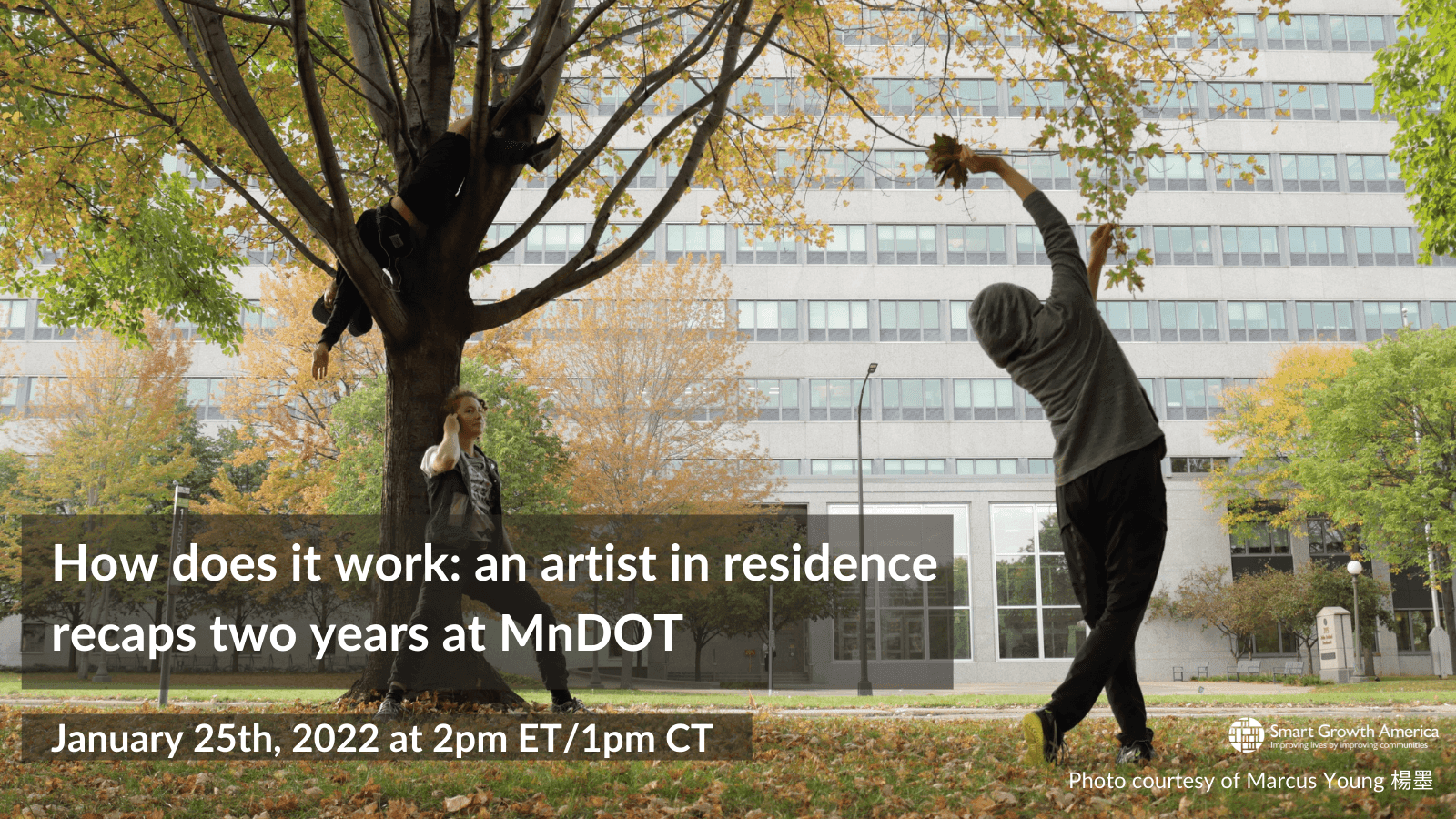
News
By Ebony Venson, February 3, 2022
Last week Smart Growth America’s Arts & Culture team hosted a conversation recapping the second year of the Minnesota Department of Transportation’s (MnDOT) innovative artist-in-residence (AiR) program. Transportation Equity Fellow, Marcus Young 楊墨 and MnDOT Strategic Partnerships Director, Jessica Oh shared their experiences, lessons learned, stories of navigating the pandemic, and goals for future programs.
The decades-old concept of integrating art within government has continued to increase in popularity as cities embed artists within their planning, parks, recreation, and transportation departments. However, it had never been done at the state level, until the Washington State Department of Transportation (WSDOT) and MnDOT launched their inaugural programs, in partnership with Transportation for America (T4A) back in the summer of 2019.
Ben Stone, SGA’s director of arts and culture Ben Stone highlighted these groundbreaking programs and underlined the essential role artists play in transportation planning, as well as the impact each of these programs had on their communities and furthering creativity and culture inside their respective DOT’s.
During his residency, behavioral artist Marcus Young has used the art of storytelling and listening to advance MnDOT’s Statewide Multimodal Transportation Plan (SMTP). Marcus hosted visioning sessions with a group of community members, notably called the “Council of Old and New Wisdom”, a group whose stories, history, and heritage are inextricably linked to the land. While existing in this world of fiction, dreaming, planning, and belonging, the council helped to catalyze the birth of the pilot art project “Turn the Highways to Rivers,” which culminated in a series of conversations about the possibilities for pushing the state plan beyond traditional boundaries and exploring innovative thinking and planning.
Marcus also hosted a conversation with MnDOT personnel during the Annual Managers’ Workshop, encouraging participants to “dream of wild” goals for the plan and their future work. This workshop provided an opportunity for staff to share their hopes and ambitions while also acknowledging the capacities needed to fulfill our wildest dreams.
Further, Marcus discussed his efforts to develop the Land Acknowledgement Confluence Room, a renovated conference room where MnDOT employees can gather, be creative, and explore new everyday cultural practices of land acknowledgment and recognition. This room exemplifies how space can be reimagined to foster creativity, whole-self engagement, deeper connection with one another, and humanizing our work.
Strategic Partnerships Director at MnDOT, Jessica Oh, also shared agency reflections on the AiR program, and this program has helped the agency creatively meet its goals and strategic plans to acknowledge the importance of place; uplift community voices, and assets; and strengthen relationships with a broad range of stakeholders.
Questions?
There were a number of questions asked during the Q&A section of the webinar that we weren’t able to get to at the end. We followed up with the presenters to discuss answers to the questions we missed.
Q1 | Often transit agencies are divided between administrative roles and field maintenance and transit operators. Did you look at this division in any of your work to instigate change?
Marcus Young: I know this topic is important to Jessica, and I was aware of it too. I had planned a statewide tour to visit most of the districts in the summer of 2020. Unfortunately, that was canceled due to the pandemic. Housed in Central Office, and as an artist based in the Twin Cities, I chose to focus on what was close at hand given the limits of resources and my own ability. This is a good question that I hope will get more attention in the future.
Q2 | How did you identify your artist for this pilot program? And what is the process for selecting future artists in residence?
Ben Stone: Marcus was selected through a competitive open call for artists, in which applicants were judged on their portfolios, responses to a series of questions, and an interview with the MnDOT team. We used a similar process to select our artist-in-residence for the third year of the program.
Q3 | How do you see continuing to integrate this into how we do our business on a daily basis? And how can we as MnDOT staff help?
Jessica Oh: As MnDOT pilots integrating new creative skills and artists to our work, the artist in residence pilot has allowed us to begin to experiment with its application in various aspects of our work – from a Statewide Planning process with the SMTP to how we view land and the communities we serve. I would encourage MnDOT departments interested in collaborating with the artists in residence to reach out. MnDOT staff can help by getting involved, participating in AIR projects, and articulating the types of projects that could use different skillsets. Ensure you share the outcomes of your collaborations with the AIRs so the collective impact can be shared and documented.
What’s next?
We are currently working on chronicling Marcus’s journey to be featured on our Scenic Route website as a resource for real-life arts and transportation collaboration.
If you are interested in starting up an AiR at your department of transportation or transit agency, we’re available to provide support and we’d love to hear from you! You can reach Ben Stone, our director of arts & culture at [email protected].
Don’t forget to sign up for arts and culture-specific updates from us here!
Related News

© 2025 Smart Growth America. All rights reserved
Site By3Lane Marketing











